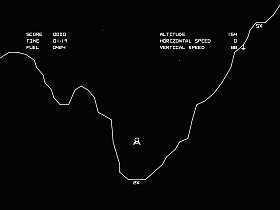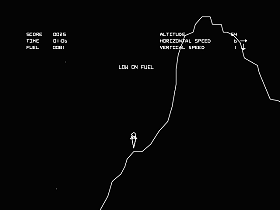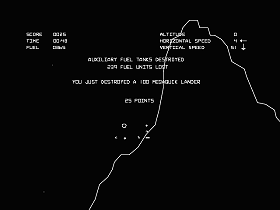
 The Game: Gene Kranz isn’t around to give you a go/no-go for landing – in Lunar Lander, you’re on your own, trying to use the least fuel to bring your lander down for a soft touchdown on the safest target area available. You can always scrub the landing by pulling the ABORT handle, or you can opt for nerves of steel and try to keep your ship – valued at 100 megabucks, incidentally – in one piece. Failure, as some associated with the moon program have been known to say, is not an option for making that one small step…but if you do litter your landing pod across the lunar landscape so many times that you run out of fuel, you can always try to salvage the space program’s integrity for another quarter. (Atari, 1979)
The Game: Gene Kranz isn’t around to give you a go/no-go for landing – in Lunar Lander, you’re on your own, trying to use the least fuel to bring your lander down for a soft touchdown on the safest target area available. You can always scrub the landing by pulling the ABORT handle, or you can opt for nerves of steel and try to keep your ship – valued at 100 megabucks, incidentally – in one piece. Failure, as some associated with the moon program have been known to say, is not an option for making that one small step…but if you do litter your landing pod across the lunar landscape so many times that you run out of fuel, you can always try to salvage the space program’s integrity for another quarter. (Atari, 1979)
Memories: Atari’s first foray into vector graphics was old news by computer mainframe standards. The basic premise of Lunar Lander had been around as a text-only game, blasting craters into college students’ productivity and computer lab time, for years.
 That incarnation of the game, however, was hardcore geek fare only: it was a play-by-turn game where the computer reported the player’s rate of descent, fuel consumption, and time left. The computer then waited for the player to type in any adjustments to thrust and direction, and the game would continue until the player landed safely – or scattered his debris over the surface of the moon.
That incarnation of the game, however, was hardcore geek fare only: it was a play-by-turn game where the computer reported the player’s rate of descent, fuel consumption, and time left. The computer then waited for the player to type in any adjustments to thrust and direction, and the game would continue until the player landed safely – or scattered his debris over the surface of the moon.
As exciting as that might have been to engineering majors in college computer labs, some major adjustments were required to make it something that arcade gamers would spend a quarter on. Atari designer Howie Delman chose to make Lunar Lander the company’s first vector graphics games because of the fast redraw rate, and even though the game is  essentially the same, only now with a graphical output instead of a text interface, the speed with which the controls and monitor respond make Lunar Lander a real-time game.
essentially the same, only now with a graphical output instead of a text interface, the speed with which the controls and monitor respond make Lunar Lander a real-time game.
Not that space exploration was any safer in the arcade than it was on top of a Saturn V filled with fuel, though. The spring-loaded “abort” handle, though a nice touch of realism, caused some potential PR grief for Atari by snapping back into place – right into the faces of young gamers or spectators whose faces were about the same height as the game’s control panel. And while Lunar Lander is fondly remembered by many, many of the games didn’t make it out of the Atari factory intact. With play-testing having created a lot of buzz about a  new space game that took players beyond the moon, many Lunar Lander cabinets were gutted and retrofitted to accomodate the anticipated demand. That new game was certainly one giant leap for Atari, easily eclipsing the success of any of the company’s previous arcade games.
new space game that took players beyond the moon, many Lunar Lander cabinets were gutted and retrofitted to accomodate the anticipated demand. That new game was certainly one giant leap for Atari, easily eclipsing the success of any of the company’s previous arcade games.
